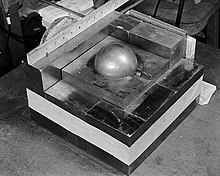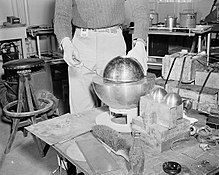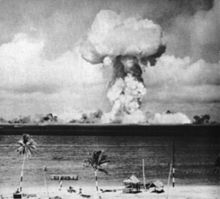Demon core
The Demon core was a 6.2-kilogram (14 lb; 1 st), 3.5-inch-diameter (89 mm) subcritical mass of plutonium that accidentally went briefly critical in two separate accidents at the Los Alamos laboratory in 1945 and 1946. Each incident resulted in the acute radiation poisoning and subsequent death of a scientist. After these incidents the spherical plutonium pit was referred to as the "Demon Core."
The Demon Core was used in the first atomic bomb test to be conducted after World War II, five weeks after the second fatal accident. It performed normally and with the same explosive yield as the next core used in this set of two tests.
First incident

On August 21, 1945, the plutonium core produced a burst of neutron radiation that caught Harry Daghlian in its path. Daghlian was a physicist who made a mistake while working alone performing neutron reflection experiments on the core. The core was placed within a stack of neutron-reflective tungsten carbide bricks, and the addition of each brick moved the assembly closer to criticality. While attempting to stack another brick around the assembly Daghlian accidentally dropped it onto the core and thereby caused the core to go critical, a self-sustaining chain reaction. Despite quick action in moving the brick off the assembly, Daghlian received a fatal dose of radiation. He died 25 days later from acute radiation poisoning.[1]
Another person who was in the lab at the time of the accident—Private Robert J. Hemmerly, a Special Engineer Detachment (SED) guard—received an exposure of approximately 31 roentgens (0.31 Gy) of soft X-rays (80 kV equivalent) and less than 1 roentgen (0.01 Gy) of gamma rays. Hemmerly died in 1978 (33 years after the accident) from acute myelogenous leukemia at the age of 62.[2]
Second incident

On May 21, 1946,[3] physicist Louis Slotin and seven other Los Alamos personnel were in a Los Alamos laboratory conducting an experiment to verify the exact point at which a subcritical mass (core) of fissile material could be made critical by the positioning of neutron reflectors. The test was known as "tickling the dragon's tail" for its extreme risk. It required the operator to place two half-spheres of beryllium (a neutron reflector) around the core to be tested and manually lower the top reflector over the core via a thumb hole on the top. As the reflectors were manually moved closer and farther away from each other, scintillation counters measured the relative activity from the core. Allowing them to close completely could result in the instantaneous formation of a critical mass and a lethal power excursion. Under Slotin's unapproved protocol, the only thing preventing this was the blade of a standard flathead screwdriver, manipulated by the scientist's other hand. Slotin, who was given to bravado, became the local expert, performing the test almost a dozen separate times, often in his trademark bluejeans and cowboy boots, in front of a roomful of observers. Enrico Fermi reportedly told Slotin and others they would be "dead within a year" if they continued performing it.[4]
While lowering the top reflector, Slotin's screwdriver slipped outward a fraction of an inch, allowing the top reflector to fall into place around the core. Instantly there was a flash of blue light and a wave of heat across Slotin's skin; the core had become supercritical, releasing a massive burst of neutron radiation. He quickly knocked the two halves apart, stopping the chain reaction and likely saving the lives of the other men in the laboratory, though it is now known that the heating of the core and shells stopped the criticality within milliseconds of its initiation. Slotin's body's positioning over the apparatus also shielded the others from much of the neutron radiation. He received a lethal dose of 1000 rads neutron/114 rads gamma[5] in under a second and died nine days later from acute radiation poisoning. The nearest person to Slotin, Dr. Alvin C. Graves, was watching over Slotin's shoulder and was thus partially shielded by him, received a high but non-lethal radiation dose of 34 neutron/166 gamma rads.[5] Graves was hospitalized for several weeks with severe radiation poisoning, developed chronic neurological and vision problems as a result of the exposure, and died of a heart attack 20 years later.[6]
Besides Graves, the others in the room were Stanley Allan Kline of Chicago, IL, physicist, died in 2001; Marion Edward Cieslicki of Mt Lebanon, PA, 11 neutron/11 gamma rads,[5] physicist, died of acute myelocytic leukemia in 1967, 21 years after the accident; Dwight Smith Young of Chicago, IL, photographer, 51 neutron/11 gamma rads,[5] died of aplastic anemia and bacterial endocarditis in 1973, 27 years after the accident; Dr. Raemer E. Schreiber of Lafayette, IN, physicist, 9 neutron/3 gamma rads,[5] died of natural causes at 88 in 1998, 52 years after the accident;[7] Theodore Perlman of Louisiana, engineer, 7 neutron/2 gamma rads[5]), "alive and in good health and spirits" as of 1978; Pvt. Patrick J. Cleary of New York City, security guard, 33 neutron/9 gamma rads,[5] died in Korea in 1952 during the Korean War; Paul Long, machinist, and another unidentified machinist, these latter two in another part of the building.[8][9]
After Slotin's accident, hands-on criticality experiments were stopped, and remote-control machines were designed by Dr. Schreiber, one of the survivors, to perform such experiments with all personnel at a quarter mile distance.[7]
Demon core in use

The Demon core was put to use for the Able detonation test of the Crossroads series on July 1, 1946.[10] Its yield was 23 kilotons, the same as the next core used in the Crossroads pair of bomb tests.
Cultural references
Charles Stross refers to the Daghlian incident in his novel The Atrocity Archives, specifically in the included short novel by similar title.
The 1989 film Fat Man and Little Boy portrays, in a character named Michael Merriman (played by John Cusack), a fictional composite of Harry K. Daghlian and Louis Slotin. The character dies of radiation poisoning after two neutron-reflection hemispheres, which are separated by a screwdriver, connect accidentally.
Joseph Kanon recounts events surrounding the first criticality accident, "Tickling the tail of the sleeping dragon [...] Testing how far we can go," in his 1997 novel Los Alamos.[11]
The story of the second accident involving the demon core (entitled "Risky Radiation") was featured in an episode of Dark Matters: Twisted But True, though the first accident is mentioned.
See also
References
- ^ Miller, Richard L. (1991). Under the Cloud: The Decades of Nuclear Testing. The Woodlands, Texas: Two Sixty Press. pp. 68, 69, 77. ISBN 0-02-921620-6.
- ^ Dion, Arnold. "Acute Radiation Sickness".
- ^ A Review of Criticality Accidents, Sept 26, 1967, LANL
- ^ Welsome, Eileen (1999). [[The Plutonium Files]] (PDF). p. 184. ISBN 978-0-385-31402-2. Retrieved 18 November 2012.
{{cite book}}: URL–wikilink conflict (help) - ^ a b c d e f g Hempelman, Louis Henry (1979-10-19). What Has Happened to the Survivors of the Early Los Alamos Nuclear Accidents? (PDF). Conference for Radiation Accident Preparedness. Oak Ridge: Los Alamos Scientific Laboratory. LA-UR-79-2802. Retrieved 5 January 2013.
{{cite conference}}: Unknown parameter|coauthors=ignored (|author=suggested) (help)There have been five studies done of the amount of radiation each person involved received in the accident; these are the latest, dated 1978, from a table in this reference. - ^ Clifford T. Honicker (1989-11-19). "America's Radiation Victims: The Hidden Files". New York Times.
- ^ a b Larry Calloway. "Nuclear Niaveté" (PDF). Albuquerque Journal.
- ^ Alsop, Stewart (March 6, 1954). "The Strange Death of Louis Slotin". Saturday Evening Post. pp. 25ff.
{{cite news}}: Unknown parameter|coauthors=ignored (|author=suggested) (help) - ^ Clifford T. Honicker (1989-11-19). "AMERICA'S RADIATION VICTIMS: The Hidden Files". The New York Times Magazine. Retrieved 2011-04-23.
- ^ Miller, Richard L (1991). Under the Cloud: The Decades of Nuclear Testing. The Woodlands, Texas: Two Sixty Press. pp. 69, 77. ISBN 0-02-921620-6.
- ^ Christopher Lehmann-Haupt (May 15, 1997). "Seeking Light: Manhattan Project Murder Mystery". The New York Times. Retrieved 3 May 2011.
External links
- McLaughlin et al. "A Review of Criticality Accidents" by Los Alamos National Laboratory (Report LA-13638), May 2000.
